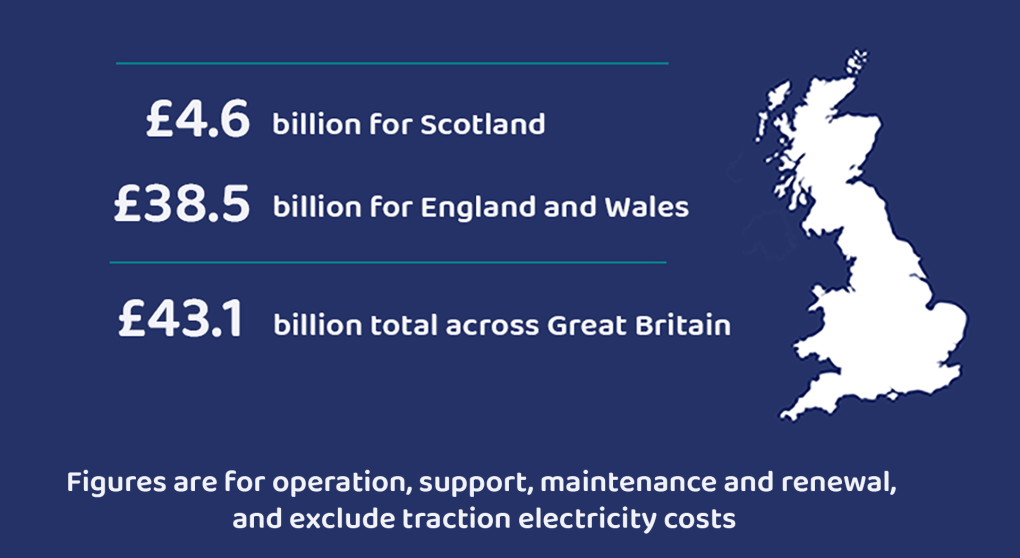Our railway provides vital public and commercial services requiring significant public investment. For the five years from April 2024, Network Rail plans to spend £43.1 billion operating, maintaining and renewing Britain’s railways. Strong checks and balances need to be in place to achieve value for money, high performance and the efficient operation of Britain’s railway.
The Office of Rail and Road’s (ORR) periodic review is one of the processes the regulator uses to hold Network Rail to account for delivery against its plans.
First, the UK and Scottish governments set out what they want Network Rail to prioritise over the next five years. Network Rail then produces its plan, and ORR ensures that the company’s plan is consistent with the priorities of the UK and Scottish governments.
It may sound technical, but ultimately the periodic review process is designed to deliver a safe and customer focused railway, and provide certainty and stability to supply chains to allow longer term investment and planning.
A key milestone in this process is the final determination – a document that sets out what Network Rail - the company that owns Great Britain’s railway infrastructure – will need to achieve over the next five years.
Final determination – setting out requirements for Network Rail
ORR’s final determination is a key date in the rail industry’s calendar, and it happens once every five years. It’s one part of how ORR – the regulator of Britain’s railway – ensures the railway is working in the interests of customers.
If Network Rail doesn’t deliver on the targets set out in ORR’s final determination, ORR has a number of tools at its disposal – including the power to compel Network Rail to act in a certain way, or fine it. This is a last resort – through regular engagement with Network Rail, ORR discusses issues as soon as they arise, so most can be addressed without formal action.
Published on 31 October, ORR’s final determination for the 2023 Periodic Review (PR23) is our approval for Network Rail’s plans for Britain’s railway.
Here are the key ways ORR’s final determination will impact our railway.
Performance, performance, performance
Initially, Network Rail suggested ranges rather than specific targets for performance and ORR called for specific commitments for rail users. In response, Network Rail improved its plans which ORR’s final determination reflects.
ORR will watch train performance closely over the five years from 1 April 2024 (known in the industry as a ‘control period’).
Supporting the freight industry
ORR works to ensure freight has fair access to the network. ORR’s final determination requires Network Rail to reduce the currently unacceptable levels of freight service cancellations. Targets for growth in the freight sector across Great Britain have also been set for the first time, supporting the UK and Scottish governments’ priorities.
Freight supports the economy and every freight service takes pressure off the country’s road network, reducing carbon emissions. However, freight services have a significant wear and tear impact on Network Rail’s infrastructure. Balancing this, the charges that freight services need to pay to access the network will increase, but will remain below the costs they impose on the network.
Renewals, maintenance and climate resilience
Britain’s railway infrastructure is made up of thousands of miles of track, as well as assets like signal boxes, overhead lines, bridges, and more. To keep the railway running smoothly, Network Rail needs to invest significant amounts of money in maintaining or renewing these assets. As climate change causes more frequent and more disruptive weather events, this needs to be an increasing area of focus for Network Rail.
Network Rail responded to the challenge we set earlier in the periodic review process and will deliver around £540mn of extra core renewals. ORR has tasked Network Rail to reduce its carbon emissions by more than 20% - transitioning to zero emissions vehicles, reducing energy use and generating renewable energy will support the achievement of this target.
Delivering value for money
Our final determination also sets out how much money Network Rail should spend in certain areas, and where it needs to make savings. We do this to deliver value for money for those who fund the railway.
We’re requiring Network Rail to set aside £1.5 billion for the network in England & Wales and £225 million for the network in Scotland, in case of unforeseen circumstances – like the high inflation seen in recent years. This ‘risk funding’, means Network Rail shouldn’t need to take money from areas like ongoing maintenance to fund short-term issues – saving money in the long term.
Network Rail will also need to demonstrate that it has made £3.2 billion in ‘efficiency savings’ on the England & Wales network and £410 million in Scotland by the end of the control period. The company could do so by simplifying processes, or using longer lasting materials and equipment.


